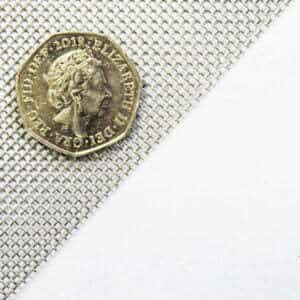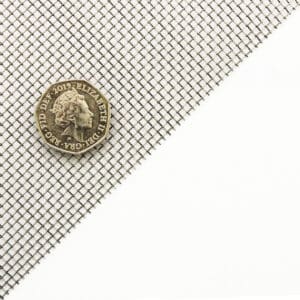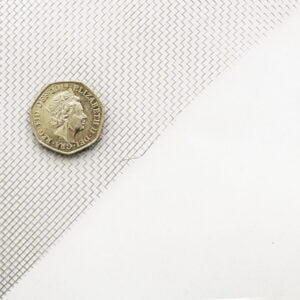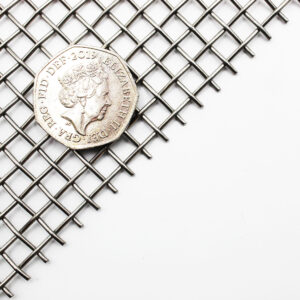







£8.99 – £379.99 inc VAT


This website is secured:
✔ The UK’s Largest Range Of Mesh Products
✔ FREE UK Delivery Included
✔ Immediate Express Dispatch From Stock
✔ Tracked Delivery with Order Updates
✔ 30-Day Returns Accepted
£ Check Out Our Clearance Listing For Savings
@ ☏ Bespoke Sizes & Larger Sheets Available
This heavy-duty stainless steel mesh filtering product boasts a 2.75mm aperture with a 75% open area, designed for durability and high-throughput filtering. Constructed from 304-grade stainless steel with a 0.43mm wire thickness, it offers strength and longevity for various applications. It features an 8 mesh count per inch, equating to 64 holes per square inch, suitable for machine guards, ventilation screens, and more.
Easy to customise with tin snips or an angle grinder, this mesh provides a sturdy and efficient solution, backed by The Mesh Company’s commitment to quality and customer service.
2.75mm hole heavy duty mesh filtering in top quality 304 grade stainless steel made from 0.43mm wire. As you can see from the image, this is a heavy woven mesh specification. 2.75mm aperture is fairly large to be woven to form a mesh netting, as a consequence it requires a thick wire to produce.
The stainless steel heavy duty mesh filtering offers a robust and reliable solution for various filtering applications. This product features a 2.75mm hole size, which is considerably large for a woven mesh, providing a substantial open area of 75%. Made from durable 304 grade stainless steel, the wire has a thickness of 0.43mm, ensuring the mesh’s strength and longevity.
With a mesh count of 8 holes per linear inch, or 64 holes per square inch, this heavy-duty mesh is designed to withstand significant stress, making it suitable for applications that require a sturdy barrier without compromising on flow rate or filtration capacity. Its substantial open area percentage allows for high throughput, which is essential in industrial processes where efficiency is paramount.
This heavy-duty filtering mesh is easy to work with despite its sturdy construction. It can be cut using tin snips, a guillotine, or an angle grinder, allowing for precision sizing and fitting for custom requirements. The ease of customisation makes it ideal for a range of uses, including machine guards, ventilation screens, or any setting where a strong, coarse filter is needed.
The specifications of this woven wire mesh are as below:
Wait!! Before you order your mesh please first check out our clearance listing which is where we put all of our over-run bargain rolls at reduced prices. You never know, you might find just the roll that you need for your purposes.
We also offer a massive range of 304 stainless steel perforated metal sheet options from immediate stock. In order to produce stainless steel perforated metal sheet, flat sheet metal is punched with round or square holes. Perforated sheets are commonly often used in applications where the passing of air is required. Because the holes are punched, it is possible to have a far stronger finished metal product than it would be for the equivalent thickness in woven or welded mesh.
Our group have been in the mesh industry for over 150 years. We are one of the UK’s most trusted mesh suppliers because:
The Mesh Company has an enormous range of woven wire mesh products. We truly are an industry leader among suppliers of weld mesh and woven wire materials. With the capabilities we have in-house, we can provide virtually anything you require.
Copper, brass, black, and galvanised steel wire mesh materials are also available in large stock quantities at bargain prices. See our blog for specific information on all of our various material options.
Here are some steps to help you select the right material for mesh filtering:
Once you have determined these factors, you can use the following formula to calculate the flow rate:
Flow rate = K * (Pressure drop) / (Viscosity * Porosity)
Yes, this mesh is commonly used as a straining element to remove large particles or debris from a fluid stream, such as in piping systems or industrial processes.
Check out our blog ‘everything that you need to know about woven filter mesh’ for more information on this product. Our goal for our blogs and help guides is to answer as many questions as possible to help to explain the possibilities of mesh to our customers. Contact our team today if you have any questions at all. We are always really keen to help in any way that we can.
You may also be interested in our blog about hardware cloth. This article explains the term in great detail.
We also offer similar products through our highly popular eBay store, check us out there too.
| Woven Mesh Sheet Size | 150 x 150mm x 2 Pack, A4 x 4 Pack (210 x 300mm x 4 Pack), 300 x 300mm (30 x 30cm) Sheet, A3 x 3 Pack (300 x 420mm x 3 Pack), 500 x 500mm (50 x 50cm) Sheet, A2 420 x 594mm (42 x 59.4cm) Sheet, A1 594 x 841mm (59.4 x 84.1cm) Sheet, 1000 x 500mm (100 x 50cm) Sheet, 1000 x 1000mm (100 x 100cm) Sheet, 5 Metre x 1000mm (1 Metre) Roll, 10 Metre x 1000mm (1 Metre) Roll |
|---|
In 2008 Locker Wire Weavers launched The Mesh Company to bring our enormous range of wire mesh products to the general public for the first time. Previously wire mesh was only available for trade customers.
We continue to extend our range, and now proudly offer many forms of mesh and metal products for the best possible prices. We specialise in woven wire mesh. As a group we work closely with architects and designers to develop ground-breaking new applications for our multifunctional range of materials. We also offer state of the art fabrication and engineering for projects of all sizes.
Strong ties with the Warrington community continue to be at the very core of our business. We are proud to invest in the training and developing our staff of all levels in line with the traditions set by Thomas Locker, who founded our group 150 years ago when he invented the electronic loom. We continue to bring ingenuity and strong ethics to our day to day business.
The Mesh Company continues Warrington’s historic role in the wire industry. For more than 140 years, our group has been a leader in the supply and manufacture of woven wire mesh and wire cloth. Having been founded in Warrington, UK in 1878, Locker mesh products still retain the quality craftsmanship and spirit of innovation that were so characteristic then.
Available Options
You will find full rolls of this insect netting here. Please be advised that the majority of woven mesh is usually available in a maximum roll size of 30 metres by 1200mm. Please email us if you wish to discuss purchasing this mesh in any size – sales@themeshcompany.com.
Feel free to call us if you wish to discuss any of our products – (+ 44) 01925 406 602. We are always happy to help in any way that we are able to.
We also offer this product through our highly popular eBay store, check us out there too.




The largest range of wire mesh, chicken wire, wire fencing, woven wire mesh and perforated metal products in Europe, delivered direct from our Warrington warehouse.




Website by: Beech Web Services | Terms and Conditions | Cookie Policy | Privacy Policy | Website Terms and Conditions
Reviews
There are no reviews yet.